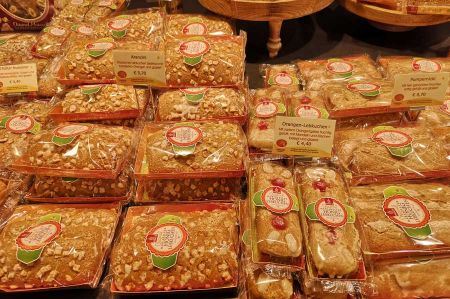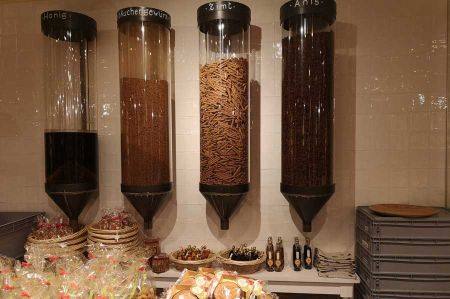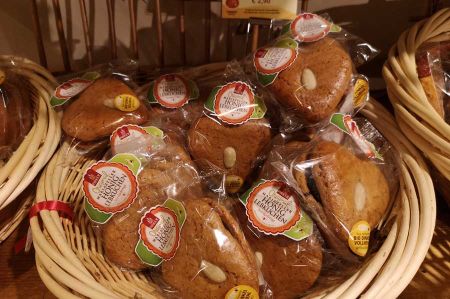Honey gingerbread - even if Christmas is not at stake
- Written by Portal Editor
Our friend Bertl had invited us for a walk in the city centre of Vienna, an invitation we gladly accepted, as there is always something special to see or do with him.
From our location Camping Wien West we first walked to line 4 at the subway station Hütteldorf, then passing 9 stations to Karlsplatz. From here it is just a few hundred meters to the centre of St. Stephen's Cathedral. A deep humming from behind together with a light touch of the shoulders caused a small shock on the stairs to Karlsplatz - Bertl had reached our meeting point almost simultaneously.
A tour with explanatory hiking of Vienna is a must, as Bertl says!

It is characteristic of all gingerbread that they are traditionally made with honey as a sweetener, with little, if any, water, milk and fat added. The dry, sugar-rich texture results in a very long shelf life. A very typical feature is that gingerbread is seasoned strongly, so that they taste extraordinarily strong and sweet overall. Typical gingerbread spices are anise, fennel, ginger, cardamom, coriander, mace, nutmeg, cloves, allspice and cinnamon. However, it is questionable what the original gingerbread recipes of the 13th century looked like, where there were no better spices like cardamom or anise from the New World.
One more reason to also look at the history of the gingerbread

The gingerbread in the form still known today was originally invented in Dinant, Belgium, then adopted and modified by the Aacheners (Aachener Printen) and finally adopted by the Franconian monasteries and slightly modified again. The nuns made the pastry for dessert. It is mentioned in Ulm as "gingerbread" as early as 1296. In the 14th century, the gingerbread was known in and around Nuremberg, where it was baked in men's monasteries. The Nuremberg gingerbread has its origin in the nearby monastery in Heilsbronn. Gingerbread was popular because of its long shelf life, because it could be stored and was distributed by the monks in bad times.
In addition to the Ratibor gingerbread, the Thorner gingerbread, also known as the Thorner cobblestones, from the West Prussian city of Thorn, which was nicknamed after the monastery of St. Catherine of Alexandria “Kathrinchen” or the Neisser confectionery, also called Neisse gingerbread, from Neisse in Silesia, which is occupied from the 16th century.
Gingerbread was also baked on wafers in monastery bakeries where hosts were already made. In southern Germany and Austria, the flat cake tents and thus the bakers were called Lebzelter. The Lebküchler or Lebzelter were united in guilds.
The advent of baking powder at the end of the 19th century also had an impact on the development of the gingerbread. The baking powder let the spicy dough rise. This resulted in many types of pastries, some of which are dense in taste and consistency and some further away from the original gingerbread, such as numerous variants of honey or spice cake.
Honey gingerbread - a well-known recipe
The preparation of honey gingerbread is a fragrance experience and is ideal as a pastry for the Advent or Christmas bakery. The Nuremberg original, the Nuremberg Elisen gingerbread, is still hard to beat. Of course, each manufacturer has its own recipe and sometimes makes it a secret. So our Lebzelter did after questioning, for that here is just a relatively well-known Hausmanns recipe
350 g honey (mountain honey type)
250 g of sugar
2-3 tablespoons of water
550 g wheat flour (type 550)
20 g gingerbread spice
1∕4 tsp lemon zest
100 g lemon
100 g orange peel
150 g almonds
12 g potash
1-2 tablespoons of whipped cream
Weigh the orange peel, lemon and lemon zest finely with a knife and work into the dough.
Dissolve the potash in the whipped cream and work into the dough.
Roughly chop half of the almonds and work into the dough.
Let the dough rest overnight.
Preheat the oven to 180 ° C.
Curl the dough to the desired thickness and cut it with templates (round or square).
Place on the baking sheet and bake for about 20 minutes.
Let cool and decorate with half of the remaining almonds.
Decorate with icing or chocolate icing.
The best flavour for the cookies develops after about a week.
Please read as well:
Dumplings - with a colourful salat and carrot ginger juice
Jubiläumswarte -Sunday walk through the Vienna walks
